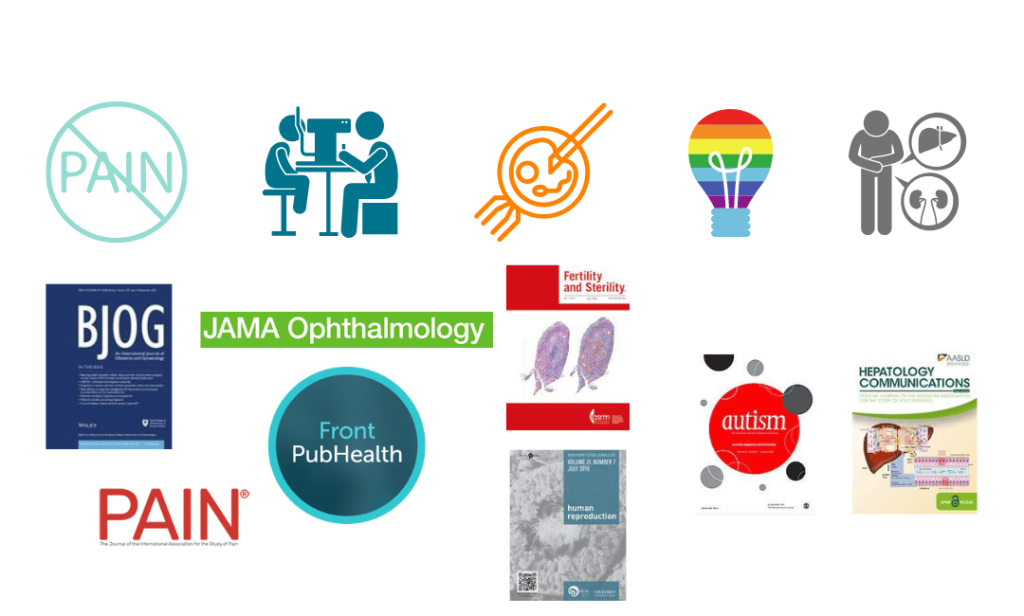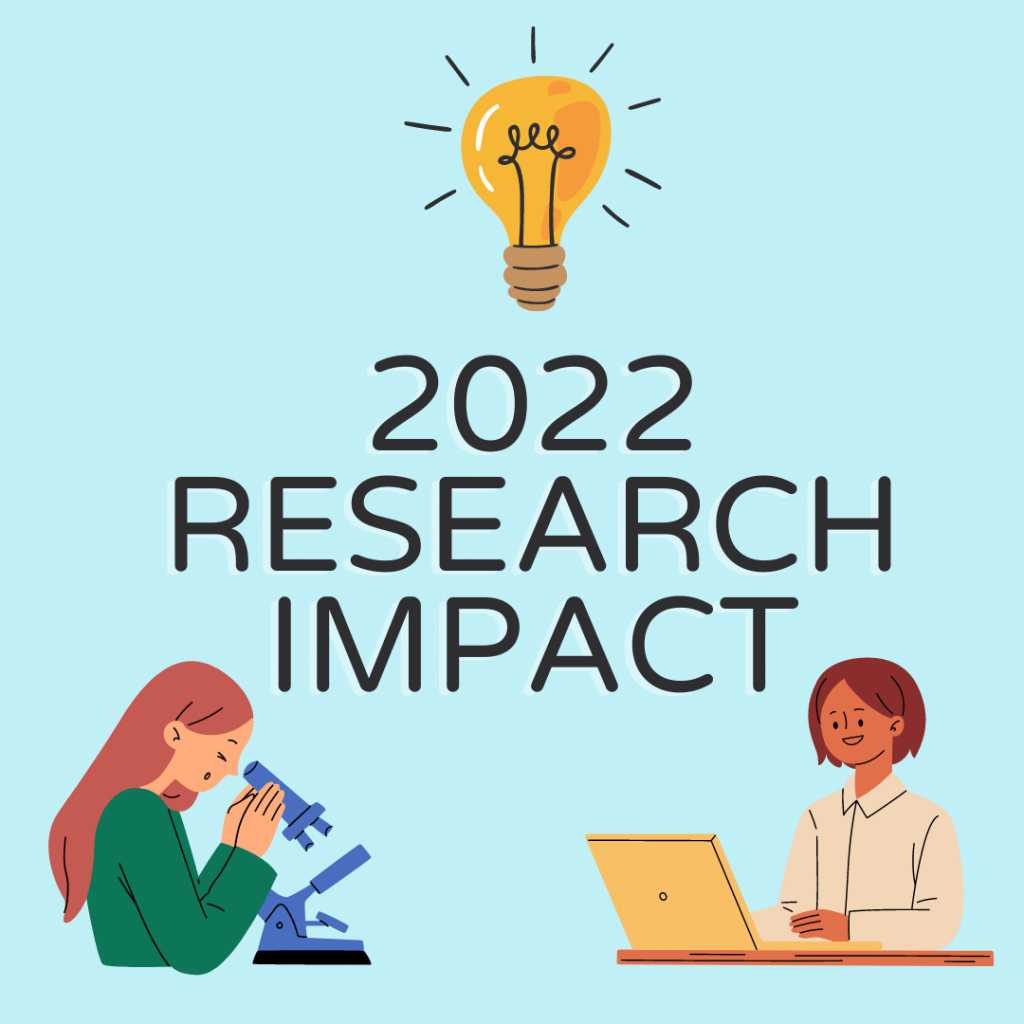January 2023: It’s been a productive 12 months for our Raine Study researchers. A total of 45 papers using Raine Study data were published in academic journals around the world in the period January-December 2022, covering a range of topics from across the human lifespan as diverse as pain, vision, cardiometabolic health, neurological development and fertility. 20 of these involved authors with international affiliations which is testimony to the reach and impact of the Raine Study globally.
We were excited to receive 43 new project applications during the 2022 calendar year, which included 22 grant applications and 21 research proposals. Of the 22 grant proposals, 12 of these will leverage the Generations follow-up which gets underway this year. Our team of data officers also facilitated 59 data access requests and 7 biosample requests, drawing on the Raine Study’s 30+ years of genetic data and biosamples.
Read on for a summary of some of our most impactful research findings in 2022.
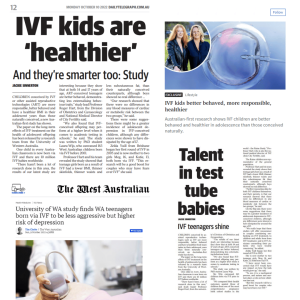 Artificial Reproductive Technology
Artificial Reproductive Technology
What are the long-term health outcomes for children conceived via artificial reproductive technologies? In a world-first study, Professor Roger Hart (The University of Western Australia) and a team of UWA-based researchers have confirmed that by the age of 20, there is no significant difference in the health of young adults conceived using ART vs their naturally conceived counterparts. 1 in 20 Australian children and 8 million people worldwide to date have been born using ART, so understanding the long-term health implications of this technology is critical. This study was only possible because of the available Raine Study data and has resulted in a series of 6x papers since July 2021 (5 in 2022) on a range of health topics. This research has also achieved significant mainstream media coverage.
No difference in the prevalence of asthma but a higher prevalence of allergies: Asthma and allergies in an adolescent cohort conceived with ART. – Reproductive Biomedicine Online, December 2022, L. Wijs et al
Less delinquent behalviour but increased levels of depression: Mental health and behavioural problems in adolescents conceived after ART. – Human Reproduction, November 2022, L. Wijs et al
Normal thyroid function: Offspring conceived through ART have normal thyroid function in adolescence and as young adults. – Human Reproduction, July 2022, L. Wijs et al
Normal fertility levels (male): Reproductive function in men conceived with in vitro fertilization and intracytoplasmic sperm injection. – Fertility and Sterility, April 2022, S. Catford et al
Normal cardiometabolic parameters: Comparison of the cardiometabolic profiles of adolescents conceived through ART with those of a non-ART cohort. – Human Reproduction, August 2022, L. Wijs et all
Normal DNA methylation profiles: DNA methylation patterns within whole blood of adolescents born from assisted reproductive technology are not different from adolescents born from natural conception. – Human Reproduction, July 2021, B. Penova-Veselinovic et al
Cohort profile paper: The Growing Up Healthy Study (GUHS)—A prospective and observational cohort study investigating the long-term health outcomes of offspring conceived after assisted reproductive technologies. – PLOS ONE, July 2022, B. Penova-Veselinovic et al
Myopia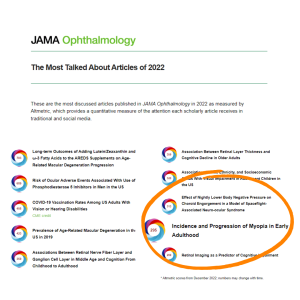
How common is the onset and progression of short-sightedness in early adulthood? While myopia tends to develop and progress fastest during childhood, this study explored the factors which might lead to the development of myopia at a later stage of life, in a young adult population. Using data from the Raine Study’s Gen2 participants (those born into the study between 1989 and 1992), this study observed significant increases in the onset of myopia over an 8 year period from 20-28 years of age, but confirmed that sun exposure from time spent outdoors was not a factor. Two papers were published based on this research in 2022 with the article in JAMA Opthamology becoming one of the top 10 articles in that journal for the year. Lead author Dr Samantha Lee (The University of Western Australia) is a postdoctoral research fellow at the Lions Eye Institute and is a member of the Raine Study’s Senses SIG.
Incidence and Progression of Myopia in Early Adulthood. – JAMA Opthamology, 2022, S. Lee et al
Prevalence and Risk Factors of Myopia in Young Adults: Review of Findings From the Raine Study. – Frontiers in Public Health, 2022, S. Lee et al
Pain
To what extent is sensitivity to pain inherited? The largest intergenerational study of the factors involved in the development and maintenance of pain, this investigation of whether sensitivity to pain is inherited or not was published in the journal Pain (April 2022) by Curtin University researcher and leader of the Raine Study’s Musculoskeletal SIG Dr Robert Waller. It found that musculoskeletal pain and pressure pain sensitivity were more likely to be inherited, but cold pain sensitivity was not.
Heritability of musculoskeletal pain and pain sensitivity phenotypes: two generations of the Raine Study. -Pain, April 2022 R. Waller et al
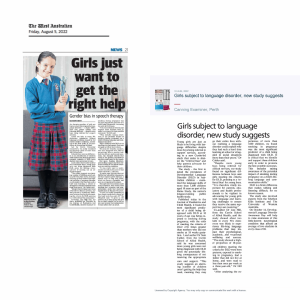 Language Development
Language Development
Girls just as likely as boys to be living with language difficulties, but less likely to be diagnosed; smoking during pregnancy a contributing factor. This paper was the first study to detail the prevalence of Developmental Language Disorder (DLD) in Australian children, by examining the language skills of more than 1,600 children aged 10 years in the Raine Study. DLD is a brain difference that makes talking and listening difficult, for no known reason. Lead author Dr Sam Calder (the Raine Study’s Psychological SIG) and a team of Curtin University researchers also confirmed that a higher proportion of 10-year-old children meeting the criteria for DLD were born preterm, exposed to smoking in pregnancy, had a father that did not live at home, and were read to less than once per week as a three-year-old. This research secured prominent coverage in WA-based general news media.
The prevalence of and potential risk factors for Developmental Language Disorder (DLD) at 10 years in the Raine Study. – J Paediatrics and Child Health, July 2022, S. Calder et al
Cardiometabolic Health
Could high blood pressure in adults be determined before birth? This paper by public health physician and UWA PhD candidate Ashish Yada showed that ultrasound during early pregnancy can help identify the factors that increase the risk of cardiovascular disease in adulthood.
The relationship between intrauterine foetal growth trajectories and blood pressure in young adults. – Hypertension, March 2022, Ashish Yadav et al